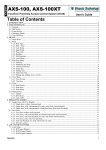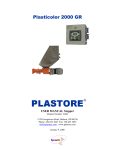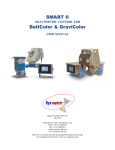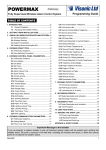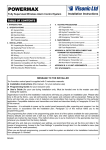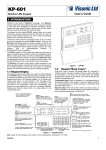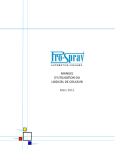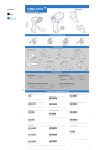Download White Outdoor 83M Specifications
Transcript
CL-83, CL-83M Installation Instructions Anti-Vandal, Access Control Keypad 1. INTRODUCTION 1.2 Indoor Keypad & Control Unit Features 1.1 Description The CL-83 is a digital programmable access control keypad. CL83M is a similar keypad - mullion type. Each system includes an outdoor, rugged, vandal resistant keypad and an indoor sophisticated microprocessor-controlled keypad, as shown in figure 1. • Functions as the "brain" of the access control system. • Includes 12 push-buttons, 3 LEDs and buzzer. • Designed to accept data from both its own keys and from the outdoor keypad. • Suitable for flush and surface mounting (supplied with a surface mounting box). Power supply 12/24V DC/AC • Includes a 10A relay, that activates the door strike or performs any desired switching function. • Programmable on site by use of its own keyboard. • Non-volatile EEPROM stores programmed data, unaffected by power failure. • Programmable relay contact closure duration; toggle (latch/ Indoor Keypad and Control Unit (CL-8A EXT) Outdoor Keypad (CL-83) Outdoor Keypad (CL-83M) Figure 1 - Using CL-83/CL-83M as an Access Control System The system users have 56 individual, preprogrammed digital codes (each code includes 1-8 digits), that they must key on the outdoor / indoor keypads, to unlock electrically controlled doors or barriers. More than 100 million code combinations are possible. A penalty timer locks out the keypads for 30 seconds after entering three consecutive erroneous codes. User codes may be individually deleted. The system has programmable AUXILIARY open-collector output with seven powerful operating modes. Each user code can be programmed to operate the internal RELAY, the AUXILIARY output, or BOTH. An AMBUSH digit, if entered after the last digit of the user code, causes a one-second pulse of the PANIC output, used to send a message to the security personnel if the user is forced to disarm the system under violence or menace. unlatch) mode may be selected if required. • PANIC output is triggered by pressing the # and * keys simultaneously, on the indoor or outdoor keypad. • REQUEST TO EXIT remote input trips the relay with a remote switch or a detector. • Tamper switch option available. 1.3 Outdoor Keypad Features • Rugged, water and vandal resistant keypad. • Includes 12 push-buttons and 2 LEDs. • All the the functions that can be performed by using the • • • • indoor keypad push-buttons can be done also by the outdoor keypad push-buttons. Tamper protected. Suitable for surface mounting. Power is received from the indoor keypad. Environmental Protection: IP68 2. SPECIFICATIONS Indoor Keypad and Control Unit (CL-8A EXT) Code composition: 1 to 8 digits, any combination Keypad type: 12 keys, 3 X 4, tactile operation Operating voltage: 9-16 or 22-26 V AC/DC, selected with jumper Current drain: 15 mA in the standby state, 55 mA with relay and AUXILIARY output active. Power failure immunity: EEPROM retains all programmed information even during total power loss. Other protections: Watch-dog protection from processor hang-up. Relay contact rating: 10A /30V AC or DC Relay control: Programmable for 1 – 98 seconds pull-in duration, or for toggle (latching/unlatching) mode. AUX and PANIC output current sinking: Up to 100 mA (each protected by an 18 ohm series resistor). LEDs: Green indicates keypad status Red and yellow have 1K ohm series resistors and terminals for external connections Operating temperature range: -20°C to 65°C (-4°F to 149°F) Size: (H x W x D): 118 x 72 x 33 mm (4-5/8 x 2-3/16 x 1-3/8 in.) Weight: 122 g (4.3 oz) Color: White Compliance with Stadards: CE DE6218 Outdoor Keypads (CL-83, CL-83M) Housing Material: Aluminium 6061 T6 Number of Keys: 12 (CL-83: 3 x 4 matrix, CL-83M: 2 X 6 matrix) Number of LEDs: 1 green, 1 red Operating Voltage: Supplied from CL-8A EXT keypad Operating and Storage Temperatures: -40°C to +125°C (104°F-257°F) Dimensions (H x W x D): CL-83: 130 x 81 x 19mm (5-1/8 x 3-3/32 x 3/4in.) CL-83M: 180 x 44 x 21mm (7-1/8 x 1-3/4 x 27/32 in.) Weight: CL-83: 290g (10 oz) CL-83M: 310g (10.9 oz) Color: Metalic gray (anodized aluminium) Compliance with Stadards: CE Environmental Protection: Waterproof and dustproof (IP68) 1 3. INSTALLATION 3.1 Indoor Keypad Mounting Outdoor Keypad CL-83 Do not install outdoors! Surface Mounting Flush Mounting Optional Standard, single-gang electrical switch box Mounting knockouts 12 11 10 9 7 6 5 4 3 2 1 Use supplied cable (see par. 3.3) Wiring knockout Indoor Keypad Mounting knockouts 100 mA MAX. Supplied box RED LED – + Wiring knockout (1 OF 2) 1K 1 Remove screws and remove the keypad from from the back box. 2 Use back box as a template, mark & drill holes in mounting surface. Fasten the back box to the mounting surface. Fasten the keypad to its back box with 2 screws. 1 Remove screws and remove the keypad back box (not used). 2 Fasten the keypad to a single-gang electrical switch box, provided that its internal dimensions are not less than 5cm (2 in.) wide by 7cm (2.8 in.) high, by using 2 screws. + – JP1 1K JP3 Figure 2. Indoor Keypad Surface and Flush Mounting 1 3.2 Outdoor Keypad Mounting 2 100 mA MAX. YEL. LED 3 4 18 5 Note: The CL-83M is designed for installation on a door frame. Drill 2 holes in the mounting surface, insert wall anchors as necessary and fasten the outdoor keypad to the mounting surface by using 2 screws. 6 7 8 + – 18 BUZ. OR REL. 9 10 11 12 BUZ. OR REL. DOOR MAGSTRIKE NETIC OR RELAY LOCK N.O. +12 OR 24 VDC – + 12V OR 24 V AC / DC POWER SUPPLY Figure 4A. Wiring with CL-83 Cable hole (**) Cable hole (**) Outdoor Keypad CL-83M Screw caps (*) Screw caps (*) RUBBER GASKET (***) RUBBER GASKET CL-83 6 - 28 V AC / DC DOOR CONTROL POWER SUPPLY CL-83M Figure 3 - Outdoor Keypad Mounting * Screw caps should be installed only after the system mounting and test is completed. ** Cable hole diameter: 10-12 mm. *** The rubber gasket is designed for mounting the CL-83/CL83M on an uneven surface and/or to prevent the formation of dampness and dust inside the keypad. 3.3 Wire Gauges and Routing Use # 20 AWG or larger diameters for relay connections to the door strike, to the control panel or any other system used. All other connections are to be made with # 22 AWG or larger. Route the wires through the wiring knockouts on the back box. Two cables (1 meter long) are supplied with the CL-83 / CL-83M, P/N PAW 80011, 6x6005/AWG#22. 6 5 4 3 2 1 7 9 10 11 12 BUZZER Use supplied cable (see par. 3.3) Indoor Keypad 100 mA MAX. RED LED – + 1K 100 mA MAX. YEL. LED + – JP1 1K JP3 18 18 3.4 Wiring IMPORTANT! Before wiring be sure to set The indoor keypad jumper JP3 in the position that corresponds with the power source you are using: 9 - 16 Volts - mount the jumper across the two pins of JP3. 22-26 Volts - remove the jumper or mount it on a single pin of JP3. Perform wiring as follows (see figure 4A/4B): A. Connect the door strike leads between one of the door control power supply terminals and terminal 11 (N.O.) of the indoor keypad. In case of a magnetic door lock, connect the lock’s leads between one of the door control power supply terminals and terminal 12 (N.C.) of the indoor keypad. B. Connect the remaining terminal of the door control power supply to terminal 10 (COM) of the indoor keypad. C. Connect the panic buzzer / relay (a 12 or 24 VDC unit, depending on power supply) between terminal 8 (PANIC) of the indoor keypad and power supply positive (+) terminal. D. Connect the auxiliary buzzer or relay (a 12 or 24 VDC unit, depending on the power supply) between terminal 9 (AUX) of the indoor keypad and the positive (+) terminal of the power supply. 2 1 2 3 4 5 6 – 7 8 + BUZ. OR REL. 9 10 11 12 BUZ. OR REL. DOOR MAGSTRIKE NETIC OR RELAY LOCK N.O. +12 OR 24 VDC – + 12V OR 24 V AC / DC POWER SUPPLY 6 - 28 V AC / DC DOOR CONTROL POWER SUPPLY Figure 4B. Wiring with CL-83M Important: When a 12VAC power source is used, LEDs connected to the PANIC or AUX open collector outputs will light normally when the output pulls down. Buzzers will not function properly, and should therefore be avoided. When a 24VAC power source is used, neither LEDs nor buzzers should be connected to the PANIC and AUX. DE6218 Notes: 1. If the system is powered from a DC power supply, the AUX and PANIC relays can be connected to terminal 7 (+). 2. The PANIC and AUXILIARY outputs each include an 18 ohm resistor in series with the output. The maximum current switching capability of each output is 100 mA. E. Connect the AC or DC power supply leads to terminals 6, 7. Caution! If the power supply provides AC, disregard polarity. If the power supply provides DC, connect the negative lead to terminal 6 and the positive lead to terminal 7 of the indoor keypad. F. Connect the remote request-to-exit switch or PIR contacts across terminals 5 and 6 of the indoor keypad. To light the red LED, connect the 12 or 24-Volt power supply across terminal 1 (+) and 2 (–) of the indoor keypad. To light the yellow LED, connect the 12 or 24-Volt power supply across terminals 3 (+) and 4 (–) of the indoor keypad. B. To protect the indoor keypad if tampering is attempted by removing the unit from the wall or by removing the front of the case. This is accomplished by opening the tamper knockout in the back box, allowing the tamper actuator to extend out of the back box and contact the wall (see Fig. 5). Note: The tamper switch is delivered as a separate item. For ordering, specify TAMP-1. When using a tamper switch, connect the tamper N.C. terminals to a control panel’s normally-closed, 24-hour protection zone, or any other system used to monitor the tamper contacts. 3.6 Outdoor Keypads Tamper Option To use the CL-83 / CL-83M Tamper switch, connect the 2 Tamper terminals (see figure 6) to Tamper N.C. terminals of an alarm control panel. 3.5 Indoor Keypad Tamper Switch Option The indoor kaypad includes tamper switch option TAMP-1, a terminal block and a tamper switch on a separate PC board. The tamper switch can be used in two ways: A. To protect the indoor keypad if tampering is attempted by removal of the front part of the case. In this configuration, the tamper actuator remains within the case, in physical contact with the inner surface of the keypad’s back box. CL-83 Tamper terminals Fig. 5 - Tamper Sw. Installation CL-83M CL-83 CL-83M Tamper terminals Figure 6 - Outdoor Keypads Tamper Switches 4. OPERATION The main function of the system is to recognize valid user codes and respond according to pre-programmed instructions. wrong code, an automatic reset results, requiring the user to wait a few seconds and then to repeat entry of the code again. 4.1 Keying Format 4.6 Lockout The user code is always followed by [#]: 4.2 Keypad Response When a valid access code is keyed, the keypad responds by activating the on-board relay (usually allocated to unlock the door), and/or activating the auxiliary circuit. Each of the 56 different access codes may be programmed to operate the onboard relay, the auxiliary output or both. The green LED illuminates for as long as the internal relay remains energized. 4.3 Latching the Relay A penalty lockout is provided to defeat “code-crackers”. Three wrong entries result in a 10 minute lockout, during which an auxiliary output is activated, but the keypad can be reset after 30 seconds by entering a valid user code. 4.7 Access under Duress If you are forced to access under threat, press the programmed AMBUSH digit after the last digit of your code. This activates the PANIC output without arousing suspicion. Enter the user code followed by the ambush digit For special applications, the relay may be toggled, so that keying the code once causes the relay to latch, and keying the code again unlatches the relay. 4.8 Operating Tips 4.4 Request to Exit A. Do not wait more than 5 seconds between successive keystrokes, or else the keypad will reset. The REQUEST TO EXIT input activates the access control relay to open the door from inside without keying a code, thereby facilitating quick and simple exit from the protected area. 4.5 Automatic Reset B. To initiate an alarm without opening the door, press simultaneously. This activates the PANIC circuit which is usually connected to a silent alarm. When keying user codes, the intervals between digits must not exceed 5 seconds. Should the user exceed this time, or enter a 5. PROGRAMMING Programming should be carried out as soon as installation is completed. This provides a set of “instructions” which determines how the keypad will react to various code inputs. Programming changes can be made as many times as necessary, but for security reasons, this operation is restricted to the “master code” holder (the master user). DE6218 5.1 Accessing the Programming Menu The programming menu is accessible only by the master user As soon as code programming takes place, this default code is automatically replaced by the first newly allocated code - No. 01. Because user code No. 01 will become the new master code, it should be assigned to the person in charge of security. 3 All code allocations should be recorded, and a User Code Programming Chart - Appendix A, is supplied for this purpose. Remember! To prevent unauthorized programming, it is important to assign a new master code which should be used for programming only. To access the programming menu: The green LED will start flashing slowly, indicating that the program- ming menu is active. You can now select various programming functions by pressing a number key from 1 to 5 (see Table 1). Table 1. Programming Menu No. Function 1 Programming user codes & their extent of control 2 Setting the relay timer Latching the relay 3 Selecting the AUX output mode 4 Deleting a single user code Deleting all user codes 5 Ambush digit Delete ambush digit Valid Entries 02 to 56 ⇒ # ⇒ [code] ⇒ # ⇒ [code (again)] ⇒ # ⇒ 1 or 2 or 3 ⇒ # 01 to 98 ⇒ # Description Assigns access codes (1 to 8 digit combination) to a person or a group of users see Par. 5.3. Sets relay pull-in duration between 1 and 98 seconds 99 ⇒ # Converts the relay to the toggle mode (latch/unlatch) 1 to 7 ⇒ # The number entered determines the operating mode (see Table 2) User number, User code corresponding to 02 to 56 ⇒ # ⇒ the user number entered is [master code] ⇒ # deleted. ÍÍ⇒ # ⇒ All user codes are deleted [master code] ⇒ # together, except for code 01 0 to 9 ⇒ # The programmed digit will be valid until deleted or replaced Í⇒ # The ambush digit is canceled Note 1: If the system detects an error during programming, the green LED goes out for 3 seconds after [#] is pressed and then reverts to slow flashing. This indicates that the data has not been accepted and the entire programming sequence should be repeated. Note 2: If you make an error while programming, press [Í] for quick return to the programming menu. 5.2 Deleting all User Codes Note: Besides the default master code (code No. 1), a specific code is programmed in the factory as code No. 2. It is therefore important to delete all codes before placing the system into service! The response will be as follows: After entering [4] – the green LED starts to flash rapidly After entering [ÍÍ] followed by [#] – the green LED lights for 2 seconds, and resumes rapid flashing. After entering the [master code] followed by [#] – the LED remains lit for 2 seconds and then reverts to slow flashing. 5.3 Programming New User Codes and Their Extent of Control Prepare a list of user codes you want to program and record them in your Programming Chart (see Appendix A). A. The user number is the number assigned to this user on the user list, not the code. The green LED lights for 2 seconds and starts to flash rapidly then repeat to verify B. The user code is any combination of numbers, up to 8 digits. The green LED lights for 2 seconds and resumes rapid flashing C. Select a trip code from the list below to determine which outputs will be tripped by the new user code. 1 to trip the relay only 2 to trip the auxiliary output only 3 to trip both the relay and the auxiliary output 4 The green LED lights steadily for 2 seconds and then flashes slowly, indicating that the data has been saved and that you are back in the programming menu. To program additional user . codes, follow the sequence A through C above, or quit by Caution! Code No. 01 will now become the master code, and will provide the only access to future programming. 5.4 Deleting Selected User Codes The response will be as follows: After entering [ 4 ] – the green LED starts to flash rapidly After entering [user number] followed by [ # ] – the green LED lights steadily for 2 seconds, then resumes rapid flashing. After entering the [master code] followed by [ # ] – the green LED remains lit for 2 seconds and then begins flashing slowly. 5.5 Setting the Relay Timer [ TT ] is the relay pull-in time To set duration from 1 to 98 seconds, enter a number from 01 to 98. To convert the relay to toggle mode (latch/unlatch), enter 99. 5.6 Selecting the AUX Output Mode [M] is a number selected from the mode column in Table 2 below. Note: User codes must be authorized to activate the auxiliary output. Table 2. Auxiliary Output Operating Modes Mode Description 1 Output is pulsed for 1 second by every user code authorized to operate the auxiliary output. 2 Output is toggled (latch/unlatch) by every user code authorized to operate the auxiliary output. 3 Output operates concurrently with the relay timer, but stays enabled 5 seconds longer than the relay (operation time: TT+5 seconds). If the toggle mode has been selected for the relay (TT= 99), the auxiliary output will be turned on for 5 seconds each time the relay is toggled. This mode does not work for user codes that are not programmed to operate the relay. 4 Latches by user codes authorized to trip the auxiliary output, unlatches by pressing Í. 5 Turned on for ten seconds by pressing any key. 6 Output oscillates at the rate of 1 Hz after 3 consecutive code errors. This condition will persist for 10 minutes, and may be reset only by entering a valid user code (resetting is possible only after the first 30 seconds, during which the keypad will be locked out as a result of the 3 code errors). 7 Output turned on by pressing 1 and 3 simultaneously. Remains on while either key is kept pressed. 5.7 Deleting the Ambush Digit If you do not intend to use an ambush digit, it is imperative that you delete the ambush digit code – to ensure that no previously programmed digit remains in memory. 5.8 Selecting an Ambush Digit [ A ] is the desired ambush digit, chosen from 0 to 9. IMPORTANT: If you have programmed an ambush digit, you must restrict user codes to seven digits each (or less) and you must avoid choosing user codes ending with that same digit as the ambush one. 5.9 How to Quit Programming while the green LED is flashing slowly The green LED will extinguish. DE6218 6. RESETTING THE DEFAULT MASTER CODE If you forget or misplace the master code (code No. 01) and it two seconds and after that will start flashing slowly, indicating that the programming menu is active. becomes necessary to reprogram the keypad, you will have to reset the master code to the factory default (1234) as follows: Important Note: The master code has temporarily reverted to 1234. Remember, however, that all other data programmed previously remains intact! E. Program a new master code (user code No. 01) immediately, and record it in a secret, safe place. If you choose to quit programming at this stage, press # while the green LED is flashing slowly. A. Open the keypad’s case, revealing the printed circuit board. B. Install the jumper across the two pins labeled JP2. (See Fig. 4). C. Momentarily short circuit the pins labeled JP1 using a screwdriver or jumper wire. D. Wait ten seconds, remove the jumper from JP2, and immediately key 1234#. The green LED will light steadily for Appendix A. User Codes List USER No. USER NAME USER CODE (1–8 DIGITS) ACTIVATES RELAY, AUX OR BOTH OUTPUTS (*) USER NUMB ER 01 02 03 04 05 06 07 08 09 10 11 12 13 14 15 16 17 18 19 20 USER NAME USER CODE (1–8 DIGITS) ACTIVATES RELAY, AUX OR BOTH OUTPUTS (*) 21 22 23 24 25 26 27 28 29 30 31 32 33 34 35 36 37 38 39 40 USER No. USER NAME USER CODE (1–8 DIGITS) ACTIVATES RELAY, AUX OR BOTH OUTPUTS (*) 41 42 43 44 45 46 47 48 49 50 51 52 53 54 55 56 * Each user can activate RELAY, AUX OR BOTH outputs, as described in paragraph 5.3C. Appendix B. Programming Summary Important! First access to the programming menu is gained through the factory default master code 1234. After programming, User Code No. 01 becomes the master code. No. Function Keying Format Format Explanation and Correct Response 1 Access to Programming Menu [ÍÍ] [Master Code] [ÍÍ] • The green LED starts to flash slowly - the programming menu is active! 2 Deleting all previous User Codes [4] [ÍÍ]# [Master Code] # • 3 Relay timing [2] [TT] # • 4 Selecting AUX output operating mode [3] [M] # • • 5 Defining an AMBUSH digit [5] [A] # • • After pressing [4] - rapid flashing; [ÍÍ] deletes all user codes except for code No. 01; After keying [ÍÍ]# - steady light for 2 seconds and then rapid flashing After keying [Master Code]# - steady light for 2 seconds and then slow flashing. After pressing [2] - rapid flashing; [TT] = 01 to 98 seconds; 99 selects the toggle mode, in which a user code will latch or unlatch the relay; After keying [TT]# - steady light for 2 seconds and then slow flashing. After pressing [3] - rapid flashing; [M] = A code specifying the operating mode of the AUX output (selected from Operating Modes Table below). After keying [M]# - steady light for 2 seconds and then slow flashing. After pressing [5] - rapid flashing; [A] = Ambush digit, 0 to 9 (see note C below) After keying [A]# - steady light for 2 seconds and then slow flashing. DE6218 • • • 5 No. Function Keying Format Format Explanation and Correct Response 6 Deleting the AMBUSH digit [5] [Í] # • 7 Programming user codes (prepare a list - see Appendix A) [1] [NN] # [C]# [C]# [F] # • • • • • Deleting individual user codes 8 [4] [NN] # [Master Code] # • • • • After pressing [5] - rapid flashing; [Í] = Deletes the Ambush digit After keying [Í]# - steady light for 2 seconds and then slow flashing. After pressing [1] - rapid flashing; [NN] = The serial number of the code user, 01 to 56 After keying [NN]# - steady light for 2 seconds and then rapid flashing. [C] = The access code allocated to this user, 1 to 8 digits After keying [C]# - steady light for 2 seconds and then rapid flashing. Repeat [C]# for verification; the LED responds as before. [F] = A code defining which outputs will be tripped by this user code 1: Authorization to trip the relay only 2: Authorization to trip the AUX output only 3: Authorization to trip both relay and AUX output After keying [F]# - steady light for 2 seconds and then slow flashing. After pressing [4] - rapid flashing; [NN] = The serial number of the code user, 02 to 56 After keying [NN]# - steady light for 2 seconds and then rapid flashing After keying [Master Code]# - steady light for 2 seconds and then slow flashing. Notes: A. B. Quit programming by pressing [#] when the green LED flashes slowly. If, while entering data, the green LED responds by going out for 3 seconds instead of lighting for 2 seconds, the data has not been accepted. Press [Í] and repeat the entire sequence from the beginning. An AMBUSH digit can not be used with 8-digit user codes, and should not be identical with the last digit in any code. The PANIC output is tripped by pressing [Í] and [#] simultaneously. C. D. Auxiliary Output Operating Modes Mode 1 2 3 4 5 6 7 Description Pulsed for 1 second by every user code authorized to operate the auxiliary output. Toggled (latch/unlatch) by every user code authorized to operate the auxiliary output. Output operates concurrently with the relay timer, but stays enabled 5 seconds longer than the relay (operation time: TT+5 seconds). If the toggle mode has been selected for the relay (TT= 99), the auxiliary output will be turned on for 5 seconds each time the relay is toggled. Note: this mode does not work for user codes that are not programmed to operate the relay. Latches by user codes authorized to trip the auxiliary output, unlatches by pressing [∗]. Turned on for ten seconds by pressing any key. Oscillates at the rate of 1 Hz after 3 consecutive code errors. This condition will persist for 10 minutes, and may be reset only by entering a valid user code (resetting is possible only after the first 30 seconds, during which the keypad will be locked out a result of the 3 code errors). Turned on by pressing 1 and 3 simultaneously. Remains on while either key is kept pressed. WARRANTY Visonic Technologies Ltd. and/or its subsidiaries and its affiliates (“the Manufacturer”) warrants its products hereinafter referred to as “the Product” or “Products” to be in conformance with its own plans and specifications and to be free of defects in materials and workmanship under normal use and service for a period of twelve months from the date of shipment by the Manufacturer. The Manufacturer’s obligations shall be limited within the warranty period, at its option, to repair or replace the product or any part thereof. The Manufacturer shall not be responsible for dismantling and/or reinstallation charges. To exercise the warranty the product must be returned to the Manufacturer freight prepaid and insured. This warranty does not apply in the following cases: improper installation, misuse, failure to follow installation and operating instructions, alteration, abuse, accident or tampering, and repair by anyone other than the Manufacturer. This warranty is exclusive and expressly in lieu of all other warranties, obligations or liabilities, whether written, oral, express or implied, including any warranty of merchantability or fitness for a particular purpose, or otherwise. In no case shall the Manufacturer be liable to anyone for any consequential or incidental damages for breach of this warranty or any other warranties whatsoever, as aforesaid. This warranty shall not be modified, varied or extended, and the Manufacturer does not authorize any person to act on its behalf in the modification, variation or extension of this warranty. This warranty shall apply to the Product only. All products, accessories or attachments of others used in conjunction with the Product, including batteries, shall be covered solely by their own warranty, if any. The Manufacturer shall not be liable for any damage or loss whatsoever, whether directly, indirectly, incidentally, consequentially or otherwise, caused by the malfunction of the Product due to products, accessories, or attachments of others, including batteries, used in conjunction with the Products. The Manufacturer does not represent that its Product may not be compromised and/or circumvented, or that the Product will prevent any death, personal and/or bodily injury and/or damage to property resulting from burglary, robbery, fire or otherwise, or that the Product will in all cases provide adequate warning or protection. User understands that a properly installed and maintained alarm may only reduce the risk of events such as burglary, robbery, and fire without warning, but it is not insurance or a guarantee that such will not occur or that there will be no death, personal damage and/or damage to property as a result. The Manufacturer shall have no liability for any death, personal and/or bodily injury and/or damage to property or other loss whether direct, indirect, incidental, consequential or otherwise, based on a claim that the Product failed to function. However, if the Manufacturer is held liable, whether directly or indirectly, for any loss or damage arising under this limited warranty or otherwise, regardless of cause or origin, the Manufacturer’s maximum liability shall not in any case exceed the purchase price of the Product, which shall be fixed as liquidated damages and not as a penalty, and shall be the complete and exclusive remedy against the Manufacturer. Warning: The user should follow the installation and operation instructions and among other things test the Product and the whole system at least once a week. For various reasons, including, but not limited to, changes in environmental conditions, electric or electronic disruptions and tampering, the Product may not perform as expected. The user is advised to take all necessary precautions for his/her safety and the protection of his/her property. 6/91 Visonic Technologies Ltd. (Israel): 24 Habarzel St. Tel Aviv 69710 ISRAEL. Tel: +972-3-768-1400 Fax: +972-3-768-1415 Visonic Technologies America (U.S.A.): 10 Northwood Drive, Bloomfield CT. 06002-1911. Tel: (860) 243-0833, (800) 223-0020 Fax: (860) 242-8094 Visonic (UK): Unit 1, Stratton Park, Dunton Lane, Biggleswade, BEDS. SG18 8QS. Tel: (01767)600857 Fax: (01767)601098 Internet: www.visonictech.com Tech. Support E-mail: [email protected] Visonic Technologies Ltd. 2003, CL-83, CL-83M, DE6218- (Rev. 1, 04/03) 6 DE6218






